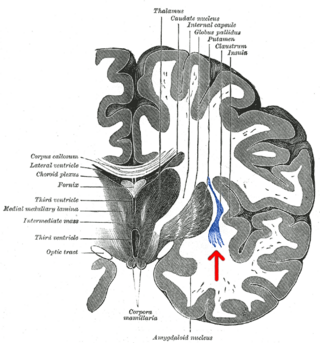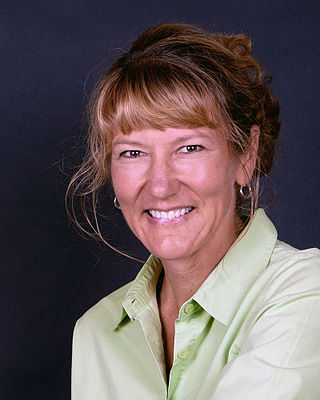Related Research Articles

The visual cortex of the brain is the area of the cerebral cortex that processes visual information. It is located in the occipital lobe. Sensory input originating from the eyes travels through the lateral geniculate nucleus in the thalamus and then reaches the visual cortex. The area of the visual cortex that receives the sensory input from the lateral geniculate nucleus is the primary visual cortex, also known as visual area 1 (V1), Brodmann area 17, or the striate cortex. The extrastriate areas consist of visual areas 2, 3, 4, and 5.
Computational neuroscience is a branch of neuroscience which employs mathematics, computer science, theoretical analysis and abstractions of the brain to understand the principles that govern the development, structure, physiology and cognitive abilities of the nervous system.

The claustrum is a thin sheet of neurons and supporting glial cells, that connects to the cerebral cortex and subcortical regions including the amygdala, hippocampus and thalamus of the brain. It is located between the insular cortex laterally and the putamen medially, encased by the extreme and external capsules respectively. Blood to the claustrum is supplied by the middle cerebral artery. It is considered to be the most densely connected structure in the brain, and thus hypothesized to allow for the integration of various cortical inputs such as vision, sound and touch, into one experience. Other hypotheses suggest that the claustrum plays a role in salience processing, to direct attention towards the most behaviorally relevant stimuli amongst the background noise. The claustrum is difficult to study given the limited number of individuals with claustral lesions and the poor resolution of neuroimaging.

The fusiform gyrus, also known as the lateral occipitotemporal gyrus,is part of the temporal lobe and occipital lobe in Brodmann area 37. The fusiform gyrus is located between the lingual gyrus and parahippocampal gyrus above, and the inferior temporal gyrus below. Though the functionality of the fusiform gyrus is not fully understood, it has been linked with various neural pathways related to recognition. Additionally, it has been linked to various neurological phenomena such as synesthesia, dyslexia, and prosopagnosia.

A cortical column is a group of neurons forming a cylindrical structure through the cerebral cortex of the brain perpendicular to the cortical surface. The structure was first identified by Mountcastle in 1957. He later identified minicolumns as the basic units of the neocortex which were arranged into columns. Each contains the same types of neurons, connectivity, and firing properties. Columns are also called hypercolumn, macrocolumn, functional column or sometimes cortical module. Neurons within a minicolumn (microcolumn) encode similar features, whereas a hypercolumn "denotes a unit containing a full set of values for any given set of receptive field parameters". A cortical module is defined as either synonymous with a hypercolumn (Mountcastle) or as a tissue block of multiple overlapping hypercolumns.
Neuroplasticity, also known as neural plasticity or brain plasticity, is the ability of neural networks in the brain to change through growth and reorganization. It is when the brain is rewired to function in some way that differs from how it previously functioned. These changes range from individual neuron pathways making new connections, to systematic adjustments like cortical remapping or neural oscillation. Other forms of neuroplasticity include homologous area adaptation, cross modal reassignment, map expansion, and compensatory masquerade. Examples of neuroplasticity include circuit and network changes that result from learning a new ability, information acquisition, environmental influences, practice, and psychological stress.

The fusiform face area is a part of the human visual system that is specialized for facial recognition. It is located in the inferior temporal cortex (IT), in the fusiform gyrus.
Repetition priming refers to improvements in a behavioural response when stimuli are repeatedly presented. The improvements can be measured in terms of accuracy or reaction time and can occur when the repeated stimuli are either identical or similar to previous stimuli. These improvements have been shown to be cumulative, so as the number of repetitions increases the responses get continually faster up to a maximum of around seven repetitions. These improvements are also found when the repeated items are changed slightly in terms of orientation, size and position. The size of the effect is also modulated by the length of time the item is presented for and the length time between the first and subsequent presentations of the repeated items.
In cognitive neuroscience, visual modularity is an organizational concept concerning how vision works. The way in which the primate visual system operates is currently under intense scientific scrutiny. One dominant thesis is that different properties of the visual world require different computational solutions which are implemented in anatomically/functionally distinct regions that operate independently – that is, in a modular fashion.
Functional magnetic resonance imaging adaptation (FMRIa) is a method of functional magnetic resonance imaging that reads the brain changes occurring in response to long exposure to evocative stimulus. If Stimulus 1 (S1) excites a certain neuronal population, repeated exposure to S1 will result in subsequently attenuated responses. This adaptation may be due to neural fatigue or coupled hemodynamic processes. However, when S1 is followed by a unique stimulus, S2, the response amplitudes should not be attenuated as a fresh sub-population of neurons is excited. Using this technique can allow researchers to determine if the same or unique neuronal groups are involved in processing two stimuli.
Visual object recognition refers to the ability to identify the objects in view based on visual input. One important signature of visual object recognition is "object invariance", or the ability to identify objects across changes in the detailed context in which objects are viewed, including changes in illumination, object pose, and background context.
Bevil Conway, is a Zimbabwean neuroscientist, visual artist, and an expert in color. Conway specialises in visual perception in his scientific work, and he often explores the limitations of the visual system in his artwork. At Wellesley College, Conway was Knafel Assistant Professor of Natural Science from 2007 to 2011, and associate professor of Neuroscience until 2016. He was a founding member of the Neuroscience Department at ey. Prior to joining the Wellesley faculty, Conway helped establish the Kathmandu University Medical School in Nepal, where he taught as assistant professor in 2002–03. He currently runs the Sensation, Cognition and Action Unit in the Laboratory of Sensorimotor Research at the National Eye Institute and the National Institute of Mental Health.

Marcus E. Raichle is an American neurologist at the Washington University School of Medicine in Saint Louis, Missouri. He is a professor in the Department of Radiology with joint appointments in Neurology, Neurobiology and Biomedical Engineering. His research over the past 40 years has focused on the nature of functional brain imaging signals arising from PET and fMRI and the application of these techniques to the study of the human brain in health and disease. He received the Kavli Prize in Neuroscience “for the discovery of specialized brain networks for memory and cognition", together with Brenda Milner and John O’Keefe in 2014.
Andreas Karl Engel is a German neuroscientist. He is the director of the Department of Neurophysiology and Pathophysiology at the University Medical Center Hamburg-Eppendorf (UKE).

Susan McConnell is a neurobiologist who studies the development of neural circuits in the mammalian cerebral cortex. She is a professor in the Department of Biology at Stanford University, where she is the Susan B. Ford Professor of Humanities and Sciences, a Bass University Fellow, and a Howard Hughes Medical Institute Professor. She is an elected member of the National Academy of Sciences and the American Academy of Arts and Sciences.
James Van Loan Haxby is an American neuroscientist. He currently is a professor in the Department of Psychological and Brain Sciences at Dartmouth College and was the Director for the Dartmouth Center for Cognitive Neuroscience from 2008 to 2021. He is best known for his work on face perception and applications of machine learning in functional neuroimaging.

Sergiu P. Pașca is a Romanian-American scientist and physician at Stanford University in California. He is known for creating and developing stem cell-based models of the human brain and applying organoids and assembloids to gain insights into neuropsychiatric disease.
Lisa Giocomo is an American neuroscientist who is a Professor in the Department of Neurobiology at Stanford University School of Medicine. Giocomo probes the molecular and cellular mechanisms underlying cortical neural circuits involved in spatial navigation and memory.
Jessica Cardin is an American neuroscientist who is an associate professor of neuroscience at Yale University School of Medicine. Cardin's lab studies local circuits within the primary visual cortex to understand how cellular and synaptic interactions flexibly adapt to different behavioral states and contexts to give rise to visual perceptions and drive motivated behaviors. Cardin's lab applies their knowledge of adaptive cortical circuit regulation to probe how circuit dysfunction manifests in disease models.
Sonja Hofer is a German neuroscientist studying the neural basis of sensory perception and sensory-guided decision-making at the Sainsbury Wellcome Centre for Neural Circuits and Behaviour. Her research focuses on how the brain processes visual information, how neural networks are shaped by experience and learning, and how they integrate visual signals with other information in order to interpret the outside world and guide behaviour. She received her undergraduate degree from the Technical University of Munich, her PhD at the Max Planck Institute of Neurobiology in Martinsried, Germany, and completed a post doctorate at the University College London. After holding an Assistant Professorship at the Biozentrum University of Basel in Switzerland for five years, she now is a group leader and Professor at the Sainsbury Wellcome Centre for Neural Circuits and Behaviour since 2018.
References
- ↑ Grill-Spector, Kalanit; Malach, Rafael (2001). "fMR-adaptation: a tool for studying the functional properties of human cortical neurons". Acta Psychologica. 107 (1–3): 293–321. doi:10.1016/S0001-6918(01)00019-1. PMID 11388140.
- ↑ Malach, Rafael (August 2012). "Targeting the functional properties of cortical neurons using fMR-adaptation". NeuroImage. 62 (2): 1163–1169. doi:10.1016/j.neuroimage.2012.01.002. PMID 22245340. S2CID 2722579.
- ↑ Profile on Linked-in
- ↑ "Kalanit Grill-Spector's Profile | Stanford Profiles". profiles.stanford.edu.
- ↑ "Editorial Board | JOV | ARVO Journals". jov.arvojournals.org.